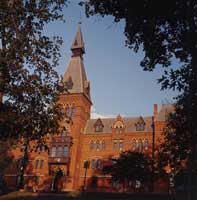Cornell University Unplugged
 One of the hottest technologies to hit campuses nationwide is Wi-Fi. Unlike
a typical slow and steady technology adoption curve, pre-installed wireless
chips in laptops, such as Intel’s Centrino, have resulted in a rapid increase
in demand for wireless access on campus. In fact, Wi-Fi is becoming a factor
for students deciding on a university in which to enroll.
One of the hottest technologies to hit campuses nationwide is Wi-Fi. Unlike
a typical slow and steady technology adoption curve, pre-installed wireless
chips in laptops, such as Intel’s Centrino, have resulted in a rapid increase
in demand for wireless access on campus. In fact, Wi-Fi is becoming a factor
for students deciding on a university in which to enroll.
Home to more than 20,000 students and 10,000 faculty and staff each year, Cornell’s
network infrastructure supports wireless-enabled laptops, PDAs, Tablet PCs and
other handheld devices in 45 buildings, as well as locations across campus where
users assemble most, such as classrooms and study areas.
Although Cornell had the foresight to predict this surge in wireless network
traffic, many large universities face significant challenges with the deployment
of wireless networks—including scalability, manageability, security, and
the impracticality of placing wireless switches in every wiring closet on campus—a
daunting task for roll-out and maintenance. Cornell University opted for a better
system—routed wireless networking. After intensive testing of several
wireless technologies, The Johnson Graduate School of Management at Cornell
University deployed Chantry Networks’ BeaconWorks wireless LAN system
in early 2003. The goal of Cornell’s next-generation WLAN deployment was
to meet the unique requirements of different wireless user groups; implement
a fully integrated network infrastructure that can be centrally managed; lower
the cost of ownership and network management; lower the administrative overhead
and headaches a switched wireless system can create; and provide greater wireless
coverage across campus.
Solving the Wireless Equation
Rather than build an entirely new wireless network, Cornell wanted to extend
its existing wired network to incorporate not just wireless access, but a state-of-the-art
wireless infrastructure. Deciding to take a phased approach to campus-wide wireless,
The Johnson School of Management at Cornell University needed a system that
would increase the size of its network over time, support all current and future
industry standards, and offer out-of-the-box interoperability with its existing
wired and wireless networking equipment. By building BeaconWorks around Layer
3 architecture—the same architecture that serves as the foundation for
the Internet—the network was able to deliver scalability and availability
beyond Cornell’s existing infrastructure.
Chantry’s BeaconWorks uses IP (Internet Protocol) as the access medium
between its BeaconPoint access points and BeaconMaster WLAN router. With BeaconWorks,
the School can centrally manage hundreds of access points and thousands of mobile
users campus-wide. Layer 3 wireless architecture also allows BeaconWorks to
easily interoperate with Cornell’s existing routed and switched networking
equipment.
Lessons Learned in
and around the Classroom
Through the testing and implementation of a variety of wireless networking technologies,
Cornell established best practices that can apply to most universities considering
a phased or large-scale wireless deployment.
• Any large-scale deployment requires access points that are inexpensive
to install and maintain, but also provide great coverage. A state-of-the-art
wireless network needs to operate with the quality of service of a wired network—not
that of a cellular network.
• Successful wireless networks are developed in a collaborative process.
Having a champion to voice the requirements of the users and shepherd the trial
phases is vital to a smooth transition, satisfied users and appropriate deployment
of network administrators.
• While one would think cellular access would be inhibited by Cornell’s
surrounding environment of mountains and gorges, in fact, it is the use of concrete
in older buildings that blocks cellular signals. By using a Layer 3 wireless
LAN, the school can have fully functioning devices and pagers.
• Look for additional features. Eventually, professors will want to limit
students’ usage of devices during lectures and class time. A wireless
system that provides virtualization (separate virtual networks) is essential
to implementing a measure of control in the classroom.
• Choose systems that interoperate with existing network equipment. No
business should build a wireless network from scratch. Time, money and resources
used to create wired networks need to be leveraged. As a result, be sure to
select a system that is backward and forward compatible.
Leveraging the Big LAN on Campus
Cornell University is building a wireless network without boundaries. Wireless
networks are no longer just about access—they are about changing the way
we interact with others using new dual-mode phones, computers, and other wireless-enabled
devices.
Cornell’s wireless initiatives continue to attract students, increase
the productivity of all constituents, and help propel the university’s
reputation as a world-class institution of higher education.
About the Author
Kevin Baradet ([email protected]) is chief technology officer at the Johnson
Graduate School of Management, Cornell University.